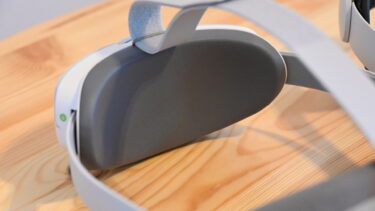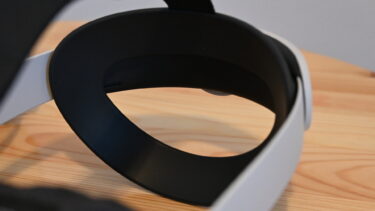Pico 4 Review: The good, the bad, and the decent
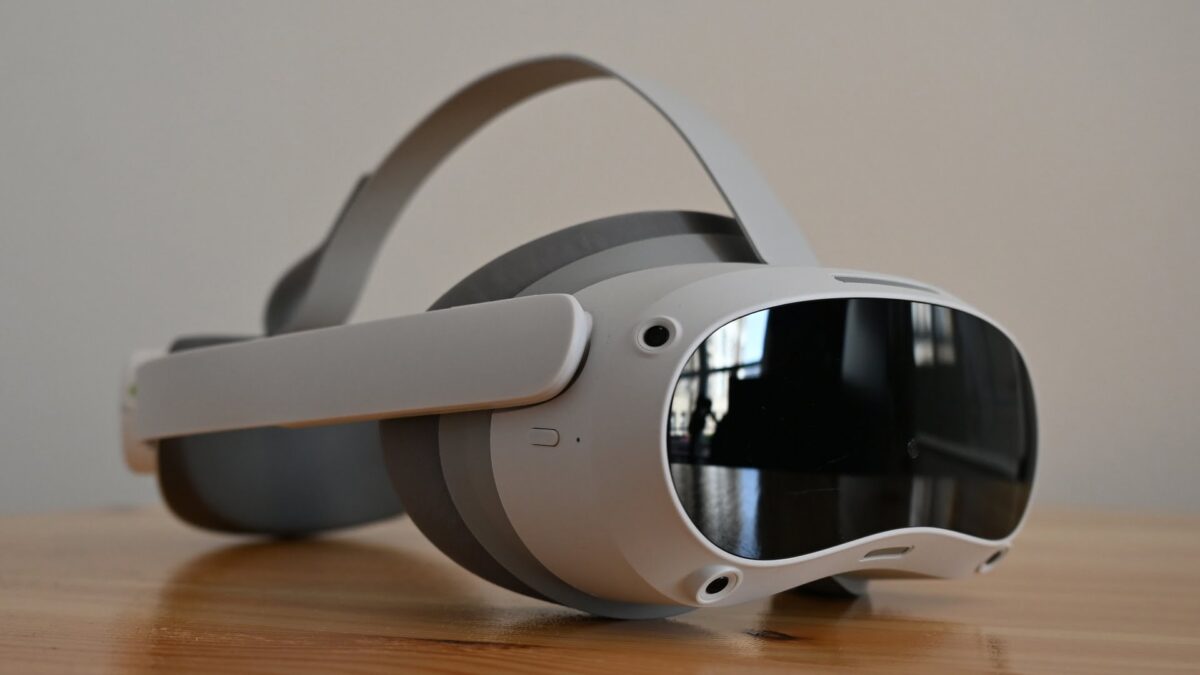
Bytedance attacks Meta's Quest 2 head-on for the first time with the VR headset Pico 4. How do they stack up?
You've probably already read it: The big Quest 2 competitor is here. Pico 4 is preparing to snatch the mobile VR crown from Meta's grasp. People are enthusiastic on YouTube and critics praise it - yes, but what else besides the obvious? After my positive first impression, I took a longer, closer look. And I am not convinced.
Content
Pico 4 Review in a nutshell
Many advantages of the Pico 4 only exist on paper. The higher resolution and the larger field of view are hardly noticeable in practice.
On the other hand, some kind of smearing or ghosting and reflections in areas with high contrast plague the image. The screen-door effect is clearly visible, partly because of some kind of "bubbles" or "holes" that appear quite irregularly in the pixel grid. The image generally appears quite dark with washed-out colors. God-rays, on the other hand, are mostly gone.
The smaller form factor and the significantly lower weight are positives. However, a suboptimal head strap design immediately negates any comfort gain from the lower weight.
Tracking and the new VR controllers work very well. The Pico Store grows very slowly, but Wi-Fi streaming and streaming via USB-C cable from Steam worked well enough for me - if there are no bugs like broken sound transmission.
If you trust your data with Bytedance more than Meta, if you can live with the risk of various bugs, and if you aren't concerned with the aforementioned problems, the Pico 4 is a viable alternative to the Quest 2.
Pico 4 is suitable for you if you ...
- want a VR headset with a really light front end,
- value a slightly higher resolution and field of view,
- prefer improved edge-to-edge clarity,
- want color passthrough,
- like the new VR controllers with the new tracking arcs,
- want decent-to-good VR streaming,
- have a sensitive budget.
Pico 4 is less suitable for you if you ...
- need an overall clear, clean, and smooth image,
- clearly notice the irregular screen-door effect,
- value a stable, comfortable headset fit,
- need color passthrough for augmented reality,
- value large native software offerings,
- live in an area where Pico doesn't (yet) offer consumer support,
- don't want to send data to China.
Setup, configuration, and battery
- Setup is easy...
- ...but the user account and WLAN cannot be configured via the app.
- The battery lasts for about two hours.
Setting up the Pico 4 is still almost the same as setting up a Quest 2 (review). Supported by videos and step-by-step instructions, the VR headset including the gaming area is quickly set up. Setup requires logging into a Pico account. This is not possible via the app, and neither is setting the Wi-Fi network. At least I do not have to know my payment details by heart - I store them in the VR Assistant app.
Battery performance is on par with Pico Neo 3 Link or Quest 2, lasting about two hours before needing a charge. Unfortunately, Pico only supplied me with a British plug for the novel charger, so I can't say anything about the supposedly fast charging time. It still takes around one-and-a-half to two hours with a normal charger.
Resolution, colors, refresh rate, and color passthrough
- The higher resolution is barely noticeable.
- Colors wash out, and the picture is comparatively dark.
- The picture has an excellent general edge-to-edge clarity, but looks "smeared" in high-contrast scenes or blurred due to reflections.
- God-rays are almost non-existent.
- The screen-door effect is clearly visible because it is not homogeneous, but has "holes".
Pico 4 has a resolution of 2,160 x 2,160 pixels per eye - higher than Pico Neo 3 Link and Quest 2, but the difference is hardly visible in practice. I think I can recognize a slightly better readability when I look closely.
The colors of the LC display look washed out and darker overall in direct comparison with the Quest 2. This is probably due to the new pancake lenses, which are much larger than the previous Fresnel lenses and do not have the typical Fresnel rings.
While God-Rays are almost completely gone, I always have the impression, especially in high-contrast scenes with bright elements, that the lenses are dirty. Bright light reflects on the lenses and creates a glare effect that always bothers me - for example in the menu, where this effect is permanently present. Fortunately, in games, and when I do not concentrate too much on individual elements in the picture, this fades into the background.
By the way, I also removed my glasses for verification to ensure that there are no reflections caused by them. In fact, when I use the Pico 4 without glasses, I see the reflections more clearly. It is possible that reflections inside the lens construction cause this effect, which I perceive as a smeary image.
This is particularly noticeable when I load an app and only the white logo is visible against a black background. If I then move my head, a mirrored copy of the logo moves along in the background.
This also applies to complete menus. If I stand in front of the menu in Walkabout Mini Golf and look into the dark spaces while moving my head, I also see the selection menu small and mirrored in the background. This could be responsible for the blurred image impression during normal use.
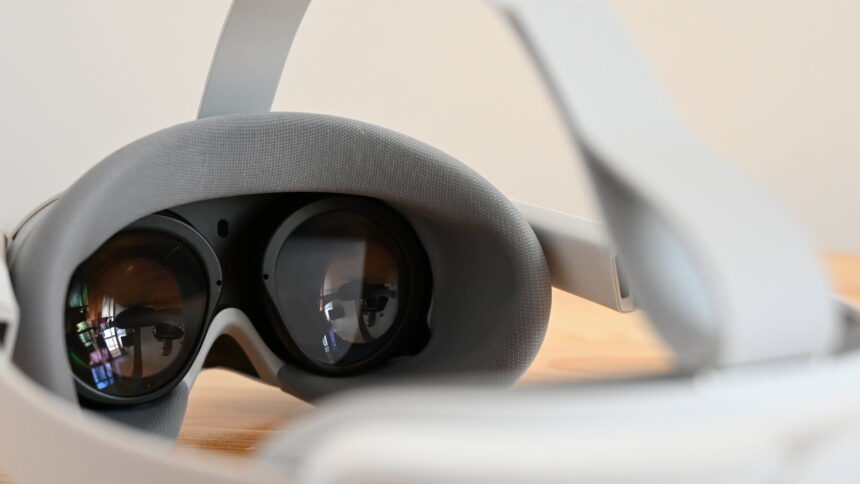
The Pico 4 relies on pancake lenses without a Fresnel cut. This makes the VR headset lighter and narrower. | Image: MIXED
However, there is something else that bothers me. The screen-door effect is clearly visible again, mainly when moving the head slowly. Especially on lighter, monochrome surfaces, I see this fine grid with every head movement and always have the impression that I'm looking through a very thin cloth.
With the Quest 2, I can also see the screen-door effect, but it is less noticeable because it is a homogeneous, fine mesh. The problem with Pico seems to be an imperfectly processed display. Inside the pixel grid, I see irregularly distributed artifacts that look like small, bright, round holes or bubbles in the "fabric" - sometimes just one, sometimes several in a bunch. This automatically makes the picture "bumpy" when moving.
The standard refresh rate is 72 Hz, as was common back on the first Quest. 90 Hz has to be activated in the settings. Meta also takes this step with the Quest Pro - I do not understand this because a higher refresh rate provides a smoother picture and is thus much more convenient.
For a long time, 90 Hz was the gold standard for VR headsets. I am not a fan of abandoning these standards in exchange for other features like longer battery life.
The color passthrough is a step in the right direction, but nothing more. The size ratios and sense of depth don't fit at all. In addition, distortions and bulges constantly move the image. If you have a sensitive stomach, you might get nauseous quickly when trying to walk around with color passthrough.
In my experiment, I was able to walk around the apartment and up and down the stairs without an accident. However, I had to pay close attention due to distorted depth perception.
Text is readable nearby, and operating my PC with the VR headset on worked well enough to make adjustments to the Link software, for example. However, the Pico 4 will not become a mixed reality headset for good passthrough AR in the near future. Maybe software updates involving the tracking cameras will do the trick eventually.
Field of view, sweet spot, and interpupillary distance
- The field of view seems larger due to the reduced distance of the lenses to the eyes - but this is hardly objectively perceptible in practice.
- The sweet spot and image clarity towards the edges are excellent.
- The IPD can be continuously adjusted between 58 and 72 mm.
One advantage of the new pancake lenses is the larger field of view. I don't even discuss the seven or ten degrees bigger field of view that Pico 4 officially claims compared to the Quest 2. Because of the huge, flat lenses, my eyes are much closer to the display than they used to be. As a result, the field of view feels much larger at first glance. This is noticeable in a positive way - as you can easily see from my Pico 4 preview.
However, a direct comparison with the Quest 2 in the same VR scene reveals that the slightly larger field of view is barely noticeable. That is also the reason I consider discussions about numbers in resolutions or field of view that are relatively close to each other to be marketing nonsense and a waste of time. In practice, 250 pixels or five degrees more do not make a significant difference.
The image clarity in the center, the so-called sweet spot, is excellent. The image clarity towards the edges, the so-called edge-to-edge clarity, is even better. While a certain blurriness sets in early on with Quest 2, I can look very far toward the edges on Pico 4 without the image losing significant clarity. This is the biggest advantage of the new VR headset in my opinion.
I enter my interpupillary distance (IPD) in the corresponding dialog, then the lenses automatically adjust. Officially, the headset supports a variable IPD of 62 to 72 mm. Theoretically, I can even go down to 58 mm, but then I run the risk that the motor-adjustable lenses will pinch my nose. A corresponding warning is displayed.
Pico 4: Wearing comfort
- The Pico 4's visor is about 40% lighter than the Quest 2's VR goggle front...
- ...but this is negated by the poor fit stability of the head mount.
I criticized it in my previous tests of the Pico Neo 3 Link and Pico Neo 3 Pro as well: The Pico VR headsets leave a lot to be desired when it comes to comfort. This is even more true for the Pico 4, I would even go so far as to say it is the most uncomfortable VR headset Pico has made so far.
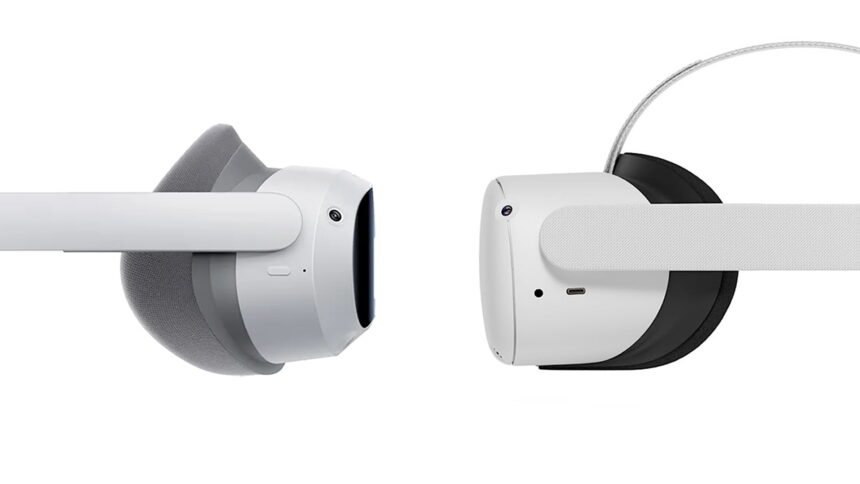
Pico 4 (left) and Quest 2 (right): The difference in form factor looks significant, but makes less of a difference in practice than hoped. | Image: Pico / Meta / MIXED
From my perspective, the reason lies in the manufacturers' tunnel vision. While the 40 percent lower weight due to the new pancake lenses on the visor (i.e., the front part of the headset) ensures noticeably less pressure on the face, the fitting stability is entirely ignored. The same goes for Meta - the Quest 2's standard strap is an imposition, and you need the Elite strap or comparable accessories to get it to fit reasonably.
Instead of learning from their experience (and from Meta's), Pico 4 relies on a non-interchangeable plastic halo head mount. The problem is the plate at the back of the head, which cannot adapt to different head shapes. While the Elite Strap head mount of the Quest 2 adapts to any head shape thanks to the wide rubber ring and thus offers a secure fit, I can only clamp the Pico 4 to my head via the adjustment wheel.
- In fact, you can see directly that this plate is hardly stable and comfortable on the back of the head.
- The rubber ring of the Elite Strap for the Quest 2 adapts to any head shape for a better fit.
Even then, it does not sit stably. Quick head movements to the right and left cause short additional lateral movements of the headset because there are only two fixed points.
The back of the head (a narrow contact surface depending on the head shape) and the forehead (an area about two centimeters wide above the eyebrows). This makes for a shaky image during fast movements, but it also squeezes the blood out of my forehead. I find that very unpleasant.
Even though my glasses fit perfectly under the Pico 4, the rather stiff face mask does not close cleanly on the right and left side and lets light through. As a result, I have annoying light reflections from outside on the lenses, especially in dark VR scenes. It might be possible to improve some just mentioned points of criticism by replacing the face gasket with a softer and overall better face-enclosing design.
(Hand)Tracking and VR controller
- Tracking of the VR headset and VR controllers is excellent.
- Hand tracking is currently not worth mentioning.
Tracking is once again exquisite, and I can hardly notice any differences compared to Quest 2. Even during fast movements in VR games, the controllers track precisely. The new VR controllers only have a minor drawback due to the new tracking brackets that run over the thumb toward the end of the VR controller.
These tracking points can sometimes be easily covered, for example, when I simply let my hands hang with the controllers. Then a large part of the bracket is very close to the body and blocked from tracking. The tracking stops, and the VR controllers start to "float". Fortunately, this happens rarely.
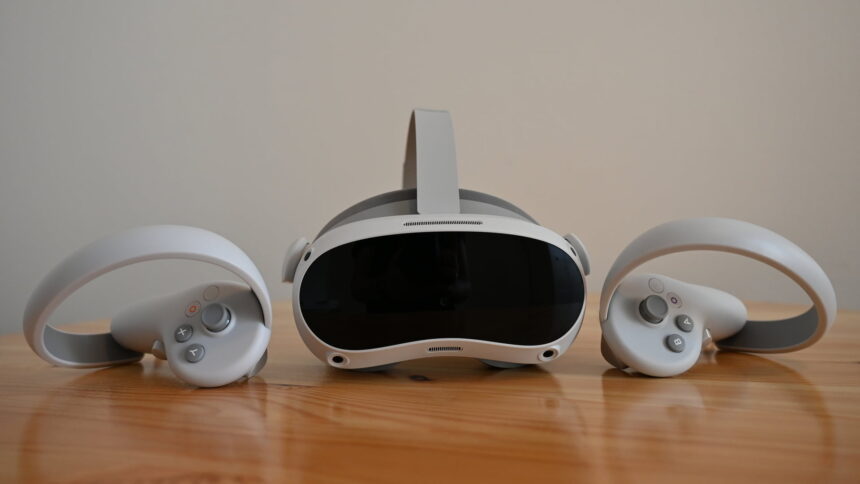
The VR controllers of the Pico 4 work perfectly. The comfort of the headset, on the other hand, leaves a lot to be desired. | Image: MIXED
The advantage of the new brackets is also rather specific. When reloading in VR games like Half-Life: Alyx or The Walking Dead: Saints & Sinners, the tracking rings no longer get in each other's way. On the other hand, the controllers can be uncomfortable for gamers with larger hands in games like Beat Saber. The little finger can get stuck between the handle and the bracket when the VR controllers slide up during fast movements.
The controllers themselves fit perfectly in my hand, and I can reach the analog stick, triggers, and buttons without any problems. There is even a dedicated button on the right controller for screenshots and video recording.
Hand tracking is available, but only if I find the secret access to the developer settings. Under Settings, I have to navigate to the "General" tab and click the "Software Version" item seven times with the trigger. Then the developer menu appears, and I can turn on hand tracking.
Currently, no apps support the Pico hand tracking and there is still a lot of potential for improvement. It is partly inaccurate, the hand movements are often interpreted incorrectly and have to be repeated several times. Ultimately this means that, outside of Pico marketing, Hand tracking for Pico 4 is currently not available.
Sound, software and Pico Store
- The integrated sound is decent.
- There is no jack port for headphones.
- The microphone solution is poor.
- The offerings in the Pico Store grow slowly.
Pico 4 does not have a jack plug for headphones. The speakers are integrated, and their sound is mostly good. However, sound enjoyment does not come up, and occasionally they seem to overdrive.
The dual microphones, on the other hand, are poor. In a test with colleagues, the transmission was unpleasant, like talking from far away through an old telephone.
As for the software, the Meta-inspired interface is largely the same. Those familiar with Quest 2 will find their way around the Pico menu. It works very well too. I haven't run into any bugs so far.
There are currently about 230 VR games and VR apps in the Pico Store. You can find a list behind the link. Over time, more apps will be added. Nevertheless, the offering is far behind that of the Quest Store. At this point, we can only hope for good streaming via cable or Wi-Fi.
Wireless and wired SteamVR streaming
- Wireless streaming works surprisingly well, partly even in the "HD" setting.
- A DisplayPort port is no longer available. Instead, streaming via USB cable is flawless.
Using the Pico Link software on my PC and the VR streaming app on the Pico 4, I can access SteamVR - assuming I have properly configured a WiFi-6 capable router or access point.
There are the settings "Smooth", "SD" and "HD". The "Smooth" setting is probably mainly focused on performance. It works well and smoothly, but the graphics are correspondingly muddy. "HD" on the other hand looks good and runs surprisingly smooth depending on the application. I tested the first 10 minutes of Half-Life: Alyx without stuttering, but Beat Saber on Expert constantly stuttered.
Sound was only a distorted mess - also via link cable. In direct comparison, the sound worked flawlessly with Meta Link and Air Link on Quest 2. This could be a bug because the sound worked well for colleagues when streaming VR with Pico 4.
DisplayPort, which used to be the unique selling point of Pico headsets, is no longer available. However, I can connect a cable via USB 3.0 to my PC via the USB-C port. This is the same streaming variant that Meta Link uses for Quest 2. I used the official cable from Meta, and it ran perfectly.
Pico 4 review conclusion: Not yet a finished VR headset
Hardware enthusiasts celebrate the pancake lenses and the saved weight on the VR headset front. However, high-contrast areas cause a smeared glare or reflection effect on the lenses. Those who value comfort will like the saved weight - however, the uncomfortable head mount remains one of the biggest weaknesses of the Pico headsets in my opinion.
The image is rarely clear and smooth. Colors look dark and washed out, and Pico has slopped on the displays. The pixel grid has uneven spots with "holes", which is why the screen-door effect is back again. The color passthrough of Pico 4 is still far from sufficient to do anything useful with it.
And what about software? The store does not yet offer the same scope as the Quest store, but Wi-Fi and cable streaming, work surprisingly well (apart from my sound problem). Provided you don't have any sound issues, this VR headset could be interesting - if the hardware concerns don't scare you.
And then we have to talk about privacy again. The privacy agreements clearly state that Pico shares all collected data with partners. It's not at all far-fetched to assume that the parent company Bytedance, which collects data in the West with Tiktok and also sends it to China, won't stop at VR data. Those who avoid Meta because of data privacy concerns cannot see Pico as an alternative.
The overall package does not convince me. Besides some excellent features, there are too many rough edges, too many things I would have to overlook. A mix of good and bad things only results in mediocrity.
Pico 4 data sheet
Note: Links to online stores in articles can be so-called affiliate links. If you buy through this link, MIXED receives a commission from the provider. For you the price does not change.
